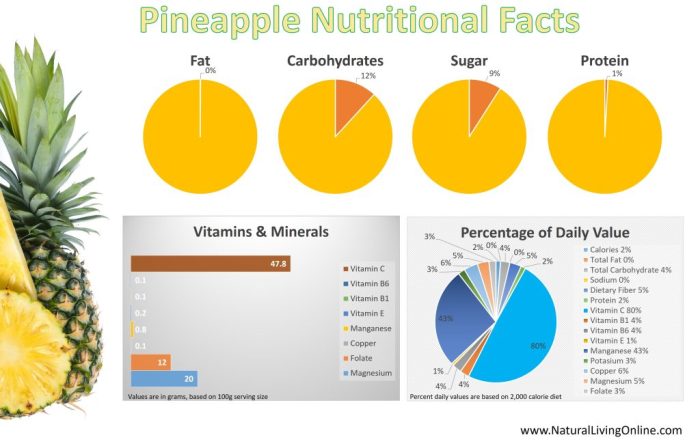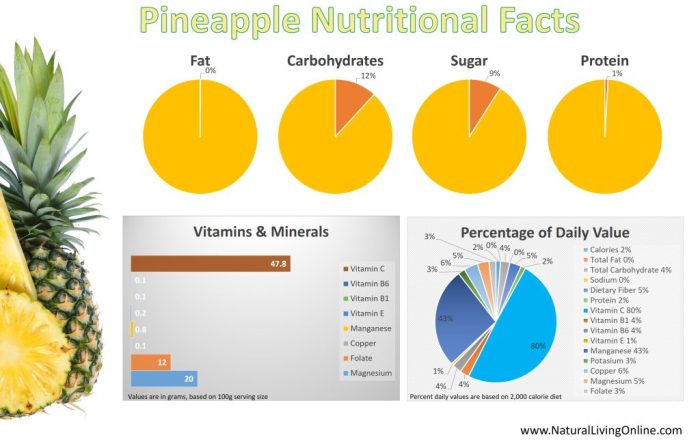What happens to your body when you eat cherries regularly? This exploration delves into the fascinating ways cherries impact your health, from boosting digestive well-being to potentially influencing sleep quality. We’ll examine the nutritional profile of cherries, comparing them to other fruits, and discuss potential benefits and considerations.
From their vibrant color to their sweet or tart taste, cherries offer a delicious pathway to potential health advantages. We’ll explore how these small fruits can affect your digestive system, blood sugar levels, cardiovascular health, inflammation, and even sleep patterns. We’ll also consider any potential interactions with medications and precautions to keep in mind.
Nutritional Composition of Cherries
Cherries, small but mighty, pack a powerful punch of nutrients. From their vibrant color to their juicy texture, these fruits offer a wide array of health benefits. Beyond their delicious taste, cherries are a treasure trove of vitamins, minerals, and antioxidants, all contributing to overall well-being. This section delves into the detailed nutritional makeup of cherries, highlighting the differences between types and exploring the crucial roles these nutrients play in the human body.A deeper understanding of the nutritional profile of cherries allows us to appreciate their potential contributions to a balanced diet.
This understanding also paves the way for informed decisions regarding their inclusion in daily dietary routines.
Vitamins, Minerals, and Antioxidants
Cherries are rich in a variety of essential vitamins and minerals. They are particularly noteworthy for their antioxidant content, which plays a crucial role in protecting the body against cellular damage. The antioxidant properties of cherries stem from a range of compounds, including anthocyanins, which give cherries their vibrant color. These compounds contribute to various physiological processes and health benefits.
Eating cherries regularly can do wonders for your body, boosting your antioxidant levels and potentially reducing inflammation. However, it’s important to consider how vitamin D deficiency might be connected to certain health issues like asthma and allergies. A recent study highlighted the link between vitamin D deficiency and increased susceptibility to these conditions, a fascinating area of research.
For more details on this connection, check out this insightful article on vitamin d deficiency causes asthma and allergies. Ultimately, a balanced diet rich in antioxidants like those found in cherries, along with sufficient vitamin D, can contribute to a healthier you.
- Vitamin C: Cherries are a good source of vitamin C, a vital antioxidant that supports immune function, collagen production, and iron absorption. The presence of vitamin C in cherries aids in the body’s defense mechanisms against infections.
- Vitamin K: Cherries contain vitamin K, essential for blood clotting and bone health. This vitamin plays a significant role in maintaining the body’s circulatory system and skeletal structure.
- Potassium: Cherries are a good source of potassium, an important mineral for maintaining healthy blood pressure and muscle function. Adequate potassium intake is crucial for the efficient functioning of various bodily systems.
- Manganese: Cherries contain manganese, a mineral involved in bone formation, wound healing, and various metabolic processes. Manganese plays a crucial role in supporting the body’s overall health.
- Antioxidants: The high concentration of antioxidants in cherries, including anthocyanins, helps protect cells from damage caused by free radicals. This antioxidant protection is vital in combating oxidative stress, a contributing factor in various health conditions.
Nutritional Differences Between Cherry Types, What happens to your body when you eat cherries regularly
Different varieties of cherries, such as sweet and sour cherries, exhibit variations in their nutritional composition. These differences are primarily due to variations in their sugar content and antioxidant profiles.
- Sweet Cherries: Sweet cherries tend to have a higher sugar content compared to sour cherries, which may affect their glycemic index. While sweet cherries offer a delightful taste, their higher sugar content should be considered as part of a balanced diet.
- Sour Cherries: Sour cherries are known for their higher concentration of certain antioxidants, particularly anthocyanins. This makes them a potential source of increased antioxidant intake, contributing to cellular protection and overall health.
Nutritional Value Comparison
The following table compares the nutritional value of cherries to other common fruits, highlighting the diverse nutrient content of these fruits. This comparison provides context for incorporating cherries into a balanced diet.
| Fruit | Vitamin C (mg) | Potassium (mg) | Antioxidant Content |
|---|---|---|---|
| Cherries (100g) | 5-10 | 150-200 | High (Anthocyanins) |
| Apples (100g) | 4-8 | 100-150 | Moderate |
| Oranges (100g) | 50-70 | 50-80 | Moderate |
| Bananas (100g) | 8-12 | 400-500 | Moderate |
Impact on Digestive Health
Cherries, beyond their delightful taste, offer intriguing potential benefits for digestive well-being. Their fiber content and impact on gut microbiota warrant exploration. Understanding how cherries interact with the digestive system can provide valuable insights into their role in overall health.Cherries contain dietary fiber, a crucial component for healthy digestion. This fiber aids in promoting regularity and preventing constipation.
Soluble fiber, in particular, can help soften stools and increase stool bulk, making it easier for the digestive system to process food. Insoluble fiber adds bulk to the stool, stimulating peristalsis, the movement of food through the digestive tract. This effect is similar to other fiber-rich foods, such as fruits like apples and pears, and vegetables like broccoli and beans.
Fiber Content and Digestive Impact
The fiber content of cherries varies depending on the type and ripeness. A significant portion of this fiber is insoluble, contributing to the bulk of the stool and facilitating smooth bowel movements. This aligns with the general effect of fiber-rich foods on digestion, promoting healthy gut motility and preventing constipation. However, individual responses to fiber intake can differ, and excessive fiber intake can lead to digestive discomfort, such as bloating and gas.
Moderation is key.
Potential Effects on Gut Bacteria
Cherries contain various bioactive compounds that might influence gut microbiota composition. Studies suggest that certain components of cherries may promote the growth of beneficial bacteria while potentially inhibiting the growth of harmful bacteria. This is a promising area of research, with potential implications for overall gut health and immune function. The impact on specific gut bacteria is still under investigation.
Further research is needed to establish a clear link between cherry consumption and specific changes in gut microbiome composition.
Comparison to Other Fiber-Rich Foods
Comparing cherries to other fiber-rich foods reveals some interesting parallels and differences. Fruits like apples and pears, known for their high fiber content, provide similar benefits for digestive health, including improved regularity and prevention of constipation. Vegetables like broccoli and beans are also rich in fiber, offering different types of fiber with unique digestive effects. The specific types and amounts of fiber in each food source determine the precise impact on digestive processes.
Individual responses to these different fiber sources may also vary.
Potential Digestive Issues
While cherries generally have positive impacts on digestive health, potential issues can arise from excessive consumption. Some individuals may experience digestive upset, including bloating or gas, especially if they are sensitive to certain components of cherries. This is particularly relevant for those with pre-existing digestive conditions. Symptoms vary and depend on the individual’s sensitivity to the components.
Digestive Enzyme Interactions
| Enzyme | Potential Cherry Interaction |
|---|---|
| Amylase | Cherries contain small amounts of carbohydrates that may be broken down by amylase, contributing to digestion. |
| Protease | The protein content in cherries is relatively low, so the interaction with proteases is minimal. |
| Lipase | Cherries have negligible fat content, thus having minimal interaction with lipase. |
| Lactase | The lactose content is minimal, implying minimal interaction with lactase. |
The table above highlights potential interactions between cherries and digestive enzymes. The low presence of specific nutrients in cherries means that the interactions with digestive enzymes are generally limited.
Influence on Blood Sugar Regulation
Cherries, particularly tart cherries, have garnered attention for their potential benefits in managing blood sugar levels. This interest stems from observations of their impact on various physiological processes, including insulin sensitivity and inflammation. While more research is needed, preliminary evidence suggests a positive correlation between cherry consumption and improved blood sugar control.
Potential Impact on Blood Sugar Levels
Studies have explored the potential link between cherry consumption and blood sugar control. Some research indicates that consuming cherries, especially tart cherries, may lead to improved insulin sensitivity and reduced blood glucose levels. This effect may be attributed to the presence of certain compounds in cherries that influence metabolic processes.
Mechanisms Influencing Insulin Sensitivity
Cherries may influence insulin sensitivity through several potential mechanisms. Anthocyanins, potent antioxidants abundant in cherries, have been shown to possess anti-inflammatory properties. Chronic inflammation is often linked to insulin resistance, and reducing inflammation could contribute to improved insulin sensitivity. Additionally, cherries may contain compounds that promote the production of certain hormones that contribute to the regulation of blood sugar levels.
Further research is necessary to fully elucidate these mechanisms.
Impact on Blood Sugar Control in Individuals with Diabetes
While preliminary data shows promise, more robust studies are needed to definitively determine the impact of cherry consumption on blood sugar control specifically in individuals with diabetes. Current research suggests that cherries may contribute to improved blood sugar control, but individual responses can vary. Consult with a healthcare professional before incorporating significant dietary changes, especially if you have diabetes.
Glycemic Index Comparison
The glycemic index (GI) measures how quickly a food raises blood sugar levels. A lower GI indicates a slower and more controlled rise in blood sugar. The GI of foods varies, and cherry’s position on this scale is relevant for those seeking to manage their blood sugar levels. Here’s a comparison of the GI of cherries to other fruits:
| Fruit | Glycemic Index (GI) |
|---|---|
| Cherries | 20-30 |
| Apples | 30-40 |
| Bananas | 51-62 |
| Grapes | 43-60 |
| Oranges | 30-50 |
Note: GI values can vary based on factors like ripeness and preparation methods. This table provides a general comparison.
Effects on Cardiovascular Health
Cherries, beyond their delightful taste, offer a potential boost to cardiovascular well-being. Their rich antioxidant profile and specific compounds are increasingly recognized for their possible role in supporting heart health. This section delves into the evidence linking cherry consumption to improved cardiovascular parameters, highlighting the mechanisms and compounds involved.The heart, a tireless muscle, is susceptible to damage from oxidative stress.
Cherries, packed with antioxidants, may help mitigate this damage. Antioxidants neutralize free radicals, unstable molecules that can contribute to cellular damage, potentially lowering the risk of cardiovascular diseases. This protective effect, backed by emerging research, makes cherries a promising addition to a heart-healthy lifestyle.
Potential Role in Promoting Cardiovascular Health
Cherries’ potential benefits for cardiovascular health stem from their high antioxidant content. This antioxidant power stems from various bioactive compounds like anthocyanins, which are responsible for their vibrant color and offer potent free radical-scavenging properties. These antioxidants can protect the heart from oxidative damage, a crucial factor in the development of cardiovascular diseases. Several studies have explored this potential relationship.
Specific Compounds Contributing to Heart Health
The most important compounds associated with cherry’s cardiovascular benefits are anthocyanins. These water-soluble pigments give cherries their deep red color and exhibit strong antioxidant properties. Other potentially beneficial compounds include phenolic acids and vitamin C. These compounds work synergistically to neutralize free radicals and reduce oxidative stress, thus contributing to overall cardiovascular health.
Eating cherries regularly can be surprisingly good for you, boosting antioxidant levels and potentially improving heart health. While that’s great, it’s also important to understand how to best respond to confabulation in dementia, a common symptom where individuals may create false memories. Ultimately, incorporating cherries into a balanced diet can bring a multitude of benefits for overall well-being.
Relationship Between Cherry Consumption and Blood Pressure Regulation
Studies suggest a possible connection between cherry consumption and blood pressure regulation. Some research indicates that consuming cherries may help lower blood pressure, though more robust, long-term studies are needed to solidify this link. Lowering blood pressure is a crucial step in preventing heart disease and stroke.
Antioxidant Content Comparison
| Fruit | Approximate Antioxidant Capacity (µmol Trolox Equivalent/100g) |
|---|---|
| Cherries | Variable, generally high, depending on variety and ripeness. |
| Blueberries | High |
| Strawberries | Moderate to high |
| Apples | Moderate |
| Grapes | Moderate to high |
Note: Antioxidant capacity can vary based on factors such as ripeness and growing conditions. The values provided are approximate and may not represent precise measurements.
This table provides a general comparison of antioxidant content in different fruits. Further research is necessary to determine the exact impact of each fruit on cardiovascular health and the specific mechanisms involved.
Role in Reducing Inflammation
Cherries, those juicy little gems, are more than just a delicious treat. Emerging research highlights their potent anti-inflammatory properties, suggesting a potential role in managing various inflammatory conditions. Their unique composition, rich in antioxidants and bioactive compounds, may contribute to reducing inflammation in the body, potentially alleviating pain and discomfort.The anti-inflammatory effects of cherries are linked to their antioxidant capacity and the presence of specific compounds like anthocyanins.
These compounds help neutralize harmful free radicals, which play a crucial role in the initiation and progression of inflammation. This antioxidant power is particularly beneficial in mitigating the inflammatory response within the body, a process that often underlies chronic pain conditions.
Anti-inflammatory Compounds in Cherries
Cherries are a concentrated source of antioxidants, notably anthocyanins, which contribute to their vibrant red color. These pigments possess strong antioxidant properties, effectively combating free radicals. These free radicals can trigger oxidative stress, a key factor in the development of inflammation.
Impact on Inflammation Markers
Studies have shown that regular cherry consumption can influence markers of inflammation in the body. For example, some research suggests that consuming cherries may reduce levels of C-reactive protein (CRP), a marker frequently associated with inflammation. Lowering CRP levels can potentially indicate a decrease in overall inflammatory activity. This is significant as elevated CRP levels are often observed in individuals with various inflammatory conditions, including arthritis.
Alleviating Pain and Discomfort
Inflammation often leads to pain and discomfort. Cherries’ anti-inflammatory properties might contribute to alleviating these symptoms. By reducing inflammation, cherries may help ease pain associated with conditions like arthritis, muscle soreness, or other inflammatory ailments. This potential pain relief can enhance overall well-being and quality of life for individuals affected by these conditions.
Potential Impact on Different Types of Inflammation
| Type of Inflammation | Potential Impact of Cherry Consumption |
|---|---|
| Arthritis (e.g., rheumatoid arthritis, osteoarthritis) | Studies suggest that cherry consumption may help reduce joint pain and inflammation, potentially improving mobility and function in individuals with arthritis. |
| Muscle Soreness/Delayed-Onset Muscle Soreness (DOMS) | Some research indicates that cherry consumption after intense exercise might help reduce muscle soreness and inflammation, facilitating quicker recovery. |
| Chronic Inflammatory Conditions (e.g., inflammatory bowel disease, psoriasis) | While promising, more research is needed to definitively determine the impact of cherry consumption on chronic inflammatory conditions. Preliminary evidence suggests a potential beneficial effect, but further studies are required to establish a clear link. |
| Post-surgical inflammation | Anecdotal evidence and some studies suggest that cherry consumption might contribute to a reduced inflammatory response after surgery, potentially accelerating recovery. |
“The potential anti-inflammatory effects of cherries are promising, but more large-scale, long-term studies are necessary to fully understand their impact on various inflammatory conditions.”
Potential Impact on Sleep Quality
Cherries, often lauded for their sweet taste and vibrant color, might hold a secret weapon in the fight against sleep disturbances. Recent research suggests a potential link between cherry consumption and improved sleep quality. This connection isn’t just anecdotal; there’s mounting evidence supporting its effectiveness in promoting healthy sleep patterns. Understanding the mechanisms behind this effect could revolutionize our approach to sleep enhancement.
Potential Benefits for Melatonin Production
Cherries contain significant amounts of melatonin, a hormone naturally produced by the body that regulates sleep-wake cycles. Consuming cherries, particularly tart cherry juice, may provide a supplemental boost to melatonin levels, potentially leading to improved sleep onset and duration. This is especially relevant for individuals with difficulty falling asleep or maintaining a consistent sleep schedule. Studies have shown that tart cherry juice can increase melatonin levels in the blood.
Influence on Sleep Cycles and Duration
The effect of cherries on sleep extends beyond melatonin production. Studies suggest that regular consumption of cherries may lead to a more restful sleep. This may involve a positive impact on sleep cycles, making them more consistent and restorative. Preliminary research suggests that cherries may help to shorten the time it takes to fall asleep and improve overall sleep duration.
This can be particularly beneficial for individuals experiencing insomnia or other sleep disorders.
Comparison to Other Sleep Aids
| Sleep Aid | Mechanism of Action | Potential Benefits | Potential Drawbacks |
|---|---|---|---|
| Cherries | Increased melatonin levels, potential modulation of sleep cycle | Improved sleep onset, potential increase in sleep duration, generally well-tolerated | Limited clinical evidence compared to some pharmaceutical sleep aids; individual responses may vary |
| Melatonin Supplements | Direct supplementation of melatonin | Promotes sleep onset | Potential for side effects like headache, nausea, and interactions with medications; some individuals experience reduced effectiveness over time |
| Prescription Sleep Medications | Act on neurotransmitters in the brain | Effective for many individuals | Potential for side effects such as daytime drowsiness, dependence, and interactions with other medications |
This table provides a concise comparison of cherry consumption to other sleep aids, highlighting their respective mechanisms, benefits, and potential drawbacks. While cherries offer a natural approach, the efficacy and safety of each option may differ, and it’s crucial to consult a healthcare professional for personalized advice.
Potential Interactions with Medications: What Happens To Your Body When You Eat Cherries Regularly
Cherries, despite their numerous health benefits, can interact with certain medications. Understanding these potential interactions is crucial for safe consumption, especially if you’re on prescribed treatments. This section delves into the possible ways cherries might affect medication efficacy or safety.
Potential Medication Interactions
A crucial aspect of incorporating cherries into your diet, if you’re taking medications, is the need for careful consideration. While cherries generally possess a positive impact on health, certain medications might experience alterations in their effects or even pose safety risks when combined with cherries.
Eating cherries regularly can boost your antioxidant intake, potentially improving heart health and reducing inflammation. However, if you notice blood in your vomit, it’s crucial to seek medical attention right away to determine the underlying cause. A thorough investigation into the potential causes of blood in vomit is important; for a comprehensive list of possible reasons, check out this resource: list of blood in vomit causes.
While cherries are generally healthy, any unusual symptoms should be addressed promptly, and this will help ensure your body is functioning optimally.
Common Medications and Potential Interactions
Consulting with a healthcare professional is paramount before adding cherries to your diet if you’re taking specific medications. This is due to the potential for interactions, ranging from minor to significant, and the need for personalized advice based on individual circumstances.
| Medication | Potential Interaction | Recommendations |
|---|---|---|
| Blood Thinners (e.g., Warfarin) | Cherries may affect the blood-thinning effect of warfarin. Some studies suggest a potential for decreased effectiveness of the blood thinner. | If you’re taking warfarin, consult your doctor before consuming cherries. Changes in the dosage of warfarin may be necessary to maintain the desired blood-thinning effect. Strict adherence to your doctor’s recommendations is essential. |
| Diabetes Medications (e.g., Metformin, Insulin) | Cherries contain natural sugars, and their consumption could affect blood sugar levels. This impact needs to be evaluated in individuals on diabetes medication, especially those with a pre-existing condition. | Consult your doctor to determine the optimal dosage adjustments of diabetes medication if you’re considering incorporating cherries into your diet. |
| Anti-inflammatory Medications (e.g., NSAIDs) | Cherries are rich in antioxidants and anti-inflammatory compounds. While generally beneficial, their combined effect with anti-inflammatory medications may potentially increase or decrease the effectiveness of the anti-inflammatory medication. | Inform your doctor about consuming cherries, especially if you are on NSAIDs, for a thorough assessment of potential interactions and adjustment to the medication. |
| Digestive Medications (e.g., antacids, laxatives) | The fiber content in cherries may interact with some digestive medications. | Consult your doctor before adding cherries to your diet if you’re taking medications for digestive issues. |
Illustrative Examples of Cherry Consumption

Cherries, with their delightful taste and potential health benefits, can be incorporated into various aspects of your daily life. Beyond enjoying them fresh, cherries offer exciting possibilities for adding flavour and nutrition to meals and snacks. This section will explore practical ways to include cherries in your diet, showcasing a variety of preparation methods and recipes.A crucial aspect of enjoying cherries is understanding how to prepare them to best maximize their flavour and nutritional value.
From simple snacking to elaborate culinary creations, cherries are versatile and adaptable.
Sample Meal Plan Incorporating Cherries
This meal plan provides a few examples of how cherries can be incorporated into your daily diet. It highlights their versatility and demonstrates how they can fit seamlessly into different meal contexts.
- Breakfast: A bowl of overnight oats topped with sliced fresh cherries, a sprinkle of almonds, and a drizzle of honey provides a wholesome and flavorful start to the day. This breakfast option is rich in fiber, antioxidants, and healthy fats.
- Lunch: A vibrant salad featuring mixed greens, grilled chicken or tofu, cherry tomatoes, and a handful of halved cherries adds a touch of sweetness and visual appeal to your lunch. The combination of nutrients supports satiety and provides essential vitamins and minerals.
- Snack: A small handful of pitted cherries provides a quick and satisfying snack, perfect for a mid-afternoon energy boost. The natural sugars in cherries can help regulate blood sugar levels and prevent energy crashes.
- Dinner: A flavorful cherry-glazed salmon dish, where cherries are used as part of the marinade, offers a healthy and delicious dinner option. This recipe showcases the ability of cherries to add a unique and delightful flavour profile to various proteins.
Cherry Preparation Methods
Different preparation methods allow you to harness the unique qualities of cherries. Understanding these methods will enhance your enjoyment and nutritional intake.
- Fresh Cherries: Enjoy fresh cherries as a standalone snack or add them to salads, yogurt, or oatmeal for a burst of sweetness and texture. Simply wash, pit (if desired), and enjoy!
- Dried Cherries: Dried cherries offer a concentrated sweetness and chewy texture. They can be used in trail mixes, baked goods, or as a topping for ice cream or yogurt. Their higher sugar content compared to fresh cherries should be considered.
- Cherry Sauce/Jam: Cherries can be transformed into delicious sauces or jams. This involves cooking cherries with sugar and other ingredients to create a thick and flavorful spread for toast, pancakes, or desserts.
- Cherry Compote: Cherry compote, often prepared with added spices, can be used as a topping for yogurt, ice cream, or cakes, adding a delightful twist. The compote also provides a rich source of antioxidants.
Cherry-Infused Recipes
Here are some examples of recipes that incorporate cherries in various ways. These recipes showcase the versatility of cherries and their ability to enhance the flavour of dishes.
- Cherry-Glazed Pork Tenderloin: Combine cherries with balsamic vinegar, honey, and spices to create a flavorful glaze for pork tenderloin. The glaze adds a sweet and tangy dimension to the dish.
- Ingredients: Pork tenderloin, cherries, balsamic vinegar, honey, garlic, and herbs.
- Preparation: Marinate the pork in a mixture of cherries, balsamic vinegar, honey, garlic, and herbs. Bake or pan-fry the pork until cooked through, basting with the glaze.
- Cherry Almond Crumble: A delightful dessert combining the sweetness of cherries with the crunch of almonds. The crumble topping adds a satisfying texture contrast.
- Ingredients: Cherries, almonds, flour, sugar, butter, and spices.
- Preparation: Combine cherries with a mixture of almonds, flour, sugar, butter, and spices. Bake in the oven until the topping is golden brown and the cherries are tender.
Visual Representation of Cherry Incorporation
| Meal Category | Cherry Preparation | Example Dish |
|---|---|---|
| Breakfast | Fresh, sliced | Overnight Oats with Cherries |
| Lunch | Halved, in salad | Mixed Greens Salad with Grilled Chicken and Cherries |
| Snack | Fresh, pitted | Handful of Cherries |
| Dinner | Glazed | Cherry-Glazed Salmon |
| Dessert | Baked, with crumble | Cherry Almond Crumble |
Potential Side Effects and Precautions

While cherries are generally safe and offer numerous health benefits, potential side effects and precautions are important considerations. Understanding these factors can help ensure that you enjoy the positive aspects of cherry consumption without compromising your well-being. A balanced approach, incorporating moderation and awareness of individual sensitivities, is key.Consuming cherries in moderation is crucial. While the benefits are substantial, excessive intake could lead to adverse reactions or interactions with specific medications.
It’s essential to be mindful of your body’s response and adjust consumption levels as needed. The potential risks vary based on individual factors, such as pre-existing health conditions or ongoing medications.
Allergic Reactions
Certain individuals may experience allergic reactions to cherries. Symptoms can range from mild skin irritation to more severe reactions like hives, swelling, or difficulty breathing. If you have a known allergy to other fruits, like apples or peaches, you may have a higher susceptibility to cherry allergies. Prompt medical attention is crucial if you suspect an allergic reaction.
Digestive Discomfort
Some individuals may experience digestive discomfort, such as bloating, gas, or diarrhea, after consuming cherries. This is often related to the natural compounds in cherries and their effect on the digestive system. This sensitivity can vary significantly from person to person.
Potential Risks for Specific Health Conditions
Individuals with specific health conditions should consult with their healthcare providers before incorporating cherries into their diet. For example, those with kidney problems might need to limit their intake due to the presence of certain compounds. Consult your doctor to determine if cherries are suitable for your specific health situation.
Interactions with Medications
Certain medications, such as blood thinners, might interact with the compounds in cherries. The combination can affect the effectiveness or safety of the medication. Always discuss the consumption of cherries with your doctor if you are taking any medications, especially those that affect blood clotting.
Summary of Potential Side Effects
| Potential Side Effect | Likelihood | Recommended Precautions |
|---|---|---|
| Allergic Reactions | Low to Moderate | If you have a known allergy to fruits, start with small portions and monitor your body’s response. Seek immediate medical attention if symptoms arise. |
| Digestive Discomfort | Low to Moderate | Start with small portions and gradually increase consumption to assess your body’s tolerance. Pay attention to any symptoms like bloating, gas, or diarrhea. |
| Interactions with Medications | Moderate to High | Always consult your doctor before adding cherries to your diet if you are taking any medications. |
| Kidney Issues | Low | Consult a healthcare professional to discuss appropriate consumption levels if you have kidney problems. |
Last Point
In conclusion, incorporating cherries into your diet could offer a variety of potential health benefits. From their antioxidant properties to their possible impact on blood sugar and sleep, cherries are a fruit worth exploring further. However, as with any dietary change, it’s always wise to consult with a healthcare professional before making significant adjustments to your routine, especially if you have underlying health conditions or are taking medications.




